 |
||||||||
 |
||||||||
 |
||||||||

One word sums up Natalie's approach to massage and bodywork: Integration.
She works by listening to your comments and goals about your session, and applies the appropriate skills to best fit your needs and expectations.
The following are some of her personal, not-so-technical definitions of the types of bodywork she performs. Simply click the items in the list to get to the descriptions.
![]()
Deep Massage
Deep Massage consists of working with the deeper layers of musculature to release adhesions, scar tissue, tension and holding patterns, or fascial restrictions (see MFR). The pace is usually slower, uses firmer, more sustained pressure, and requires less oil or cream. The idea is to traction the tissues of the deeper muscles, so excess slide and glide over the skin is not ideal. Some deep massage strokes consist of deep frictioning, sustained pressure with fingers, elbows or loose fists, or "ironing" down the length of a muscle.
Contrary to popular miconceptions, deep massage needn't be "painful," and in many cases can be a soothing, productive, and validating form of bodywork to receive. Deep massage is indicated when there is a desire or need to reduce long-standing or chronic tension in a group of muscles, to work on postural change, or to work with injury prevention and recovery.
My personal approach to using deep massage stems from how it was taught by one of my instructors. He said that he intentionally refers to it as "Deep Massage" as opposed to "Deep Tissue Massage" because its application revolves around affecting someone "deeply." This can look many ways, from a very specific anatomical massage session, or somtimes it may simply be resting a hand on someone's shoulder. The skill in the practitioner comes with knowing when to do what.
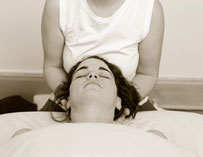
![]()
Sports Massage
Sports Massage isn't a specific "type" of massage as much as it is a methodology of how and when to apply various massage protocols and techniques. It takes into consideration a client's training and/or competition schedule, and works within that framework to optimize performance, speed recovery, and help prevent injury.
Swedish techniques are used to flush tissues and enhance circulation, while deeper, more tissue-specific forms of bodywork are applied when there is enough time to affect and recover from structural changes. A few examples of "structural changes" include: working to increase flexibility, dissipating any scar tissue or adhesions, and addressing any postural issues that may interfere with athletic performance or function.
Although the term says, "Sports Massage," one does not have to be a professional athlete or in serious training to benefit from this approach to massage. In our own ways, we are all athletes who use our bodies in certain, specific, repetitive ways to get through our daily routines. We haul large shoulder bags or purses, hunch over computers, clean house, hoist children, work out, climb stairs, and a myriad of other physical activities countless times each day. What kind of athlete are you?
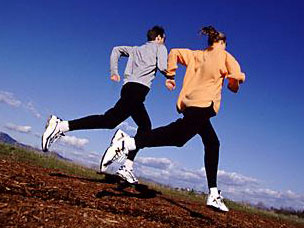
![]()
Swedish Massage
When you see massage represented on television, film or print materials, most of the time it's Swedish Massage that you see. The strokes are long, gliding, or kneading, and are aided along by the use of oil or cream on the skin. It also may include stretches and range of motion exercises. Swedish massage is designed to flush the circulatory and lymph systems, increase flexibility, and reduce stress. It is a lovely thing and feels really, really, good to receive!
Swedish massage ranges anywhere from light to firm pressure according to client taste, and anatomically, it works with the superficial-most layers of musculature. An hour of Swedish massage flushes the circulatory system to the same extent as an hour of aerobic exercise (though Swedish massage does not exercise your heart. This refers only to rate of bloodflow).
One thing to note about Swedish massage: It is extremely healthful and beneficial to the body in a whole host of ways, but by its definition, it is too general to significantly affect major structural issues. For example, a client with an old shoulder injury may benefit from the increased circulatory and lymph drainage resulting from the session, but deep massage and MFR will be necessary to address any scar tissue or adhesion issues.
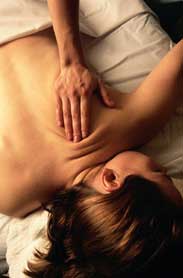
![]()
Myofascial Release
Myo = Muscle
Fascia = Layers of fibrous tissue covering and separating muscle. It is the connective tissue that surrounds, supports, and connects all the various parts of us from head-to-toe.
Myofascial Release is a type of bodywork that puts the emphasis on working with the body's connective tissues to restore muscle flexibility and range of motion, dissipate scarring or tissue adhesions, and affect postural and structural change. MFR can be incorporated into a deep massage session, though by no means is all deep massage MFR. MFR looks and feels more like a diaolgue between the practitioner and the client's connective tissues and neural receptors. The practitioner applies pressure and direction in an effort to "coax" the body to release tension and fascial restrictions. Since fascia surrounds every single part of our bodies, it is incredibly important to include it in any bodywork regimen.
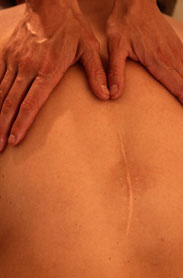
![]()
Structural Bodywork
Structural Bodywork is a bodywork approach which includes a combination of assessment, and then action based upon those observations. The therapist does an assessment of the client's posture and subsequent tension patterns in order to determine a bodywork plan aimed at restoring postural balance, and reestablishing the client's centeredness within the field of gravity. (Breathe!)
That is a lofty way of stating that if one has hunched posture, or tilts slightly to one side because of muscle tension or a fallen arch, these will set up a whole host of other tension patterns and joint misalignments, since this person is essentially off-balance. Walking around lop-sided in this thing on earth we call Gravity makes for excess strain and further tension and postural imbalance.
In a structural bodywork assessment session, the client arrives with either workout apparel, a bathing suit or other form-fitting yet easy-moving clothing. Form fitting clothing is helpful so that the therapist can really see how the client's body holds itself. However, client modesty and personal comfort are always respected. The therapist will examine how the clients stands, look at how the client's limbs and joints hang and articulate, will check the angle of the hips and pelvis and various other postural observations, including perhaps even examining the wear pattern on the client's shoes. Then, over a series of sessions, the client receives appropriate massage and bodywork necessary to restore balance particular to their individual case. Sometimes before and after photos may be taken-- and the results can be truly amazing!
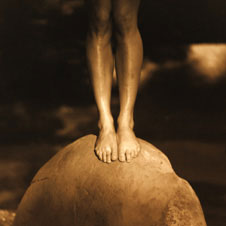
![]()
Pregnancy and Post-Partum Massage
This includes any massage and bodywork centered around the ever-changing physiological states of expectant and post-partum mothers. Table sessions consist of proper bolstering and support to accommodate mom's growing belly, and beyond the first trimester, table sessions are typically done with the client in a side-lying position.
The types of techniques indicated for prenatal massage vary throughout the term of the pregnancy, and require the therapist to have a special understanding of pregnancy anatomy and physiology. Natalie has over 300 hours of training in this area.

![]()
On-Site Chair Massage
Seated chair massage is a fantastic way to get to know what massage is all about! It is a great introduction for new clients, and is a fantastic way to offer a de-stresser to office staff or at special events. It's done in anywhere from 5-30 minutes sessions, requires no disrobing, and is extremely effective in taking the edge off a busy day. This sends workers back to their desks refreshed and rejuvenated and enhances morale and prodcutivity. Chair massage is also great for people who cannot get on or off of a massage table.
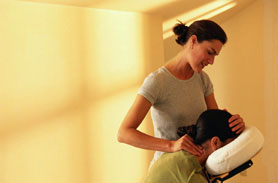
![]()
Infant Massage Classes
Natalie Durkin, RMT is a certified Infant Massage instructor through the International Institute of Infant Massage. Classes are appropriate for newborns all the way through preschool and beyond! The purpose and scope of infant massage is huge. Some of its goals are: to teach parents and other primary caregivers how to massage their children for the purpose of enhanced bonding, fostering better communciation through more effective reading of infant cues, to help heal any developmental traumas from pre-term or difficult deliveries, to stimulate motor skill development, and something that is so crucial in today's sometimes dangerous world-- it teaches children from very early on what is, and is not, safe touch.
Classes may be held individually or in groups, and are conducted in units consisting of 4 one-hour classes each.
